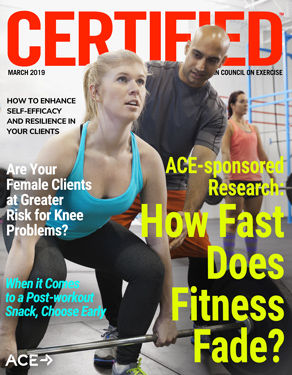
As a health and exercise professional, you probably got into this field, in part, because you love helping people succeed and meet their goals. You likely spend hours researching new health information and reading the latest in fitness research. You’re all about health and fitness. But what about the business end of your work?
If you’re like me, you’re not overly comfortable with selling yourself and your services. You don’t like feeling pushy or coming across as only caring about making the sale. For some of you, this may be a completely new mindset, as you never thought about your work in this way. But if you want to pick up new clients, there is a certain amount of marketing—of yourself and your business—that you must do.
However, what if you didn’t have to do any selling to fill your schedule with clients? What if all you had to do was based on what you're already doing?
Just Teach
Traditional marketing is all about the sales pitch and making money off the customer. I dare say most people hate feeling like they’re being pushed into a sale. My reaction is usually to push back—or run. Whether it’s for a product or service, this type of selling doesn't do much to build rapport and can make the prospect feel used and distrustful.
And trust, according to recent data released by SurveyMonkey, is a priority in consumers’ purchasing decisions.
“Businesses that fail to establish trust—the foundation of any relationship—will lose to businesses who can,” said SurveyMonkey CEO Zander Lurie in a press release. “You need trust to win customers, and you need to build on that trust to keep them. Our research shows the key to establishing this kind of trust begins by listening to your customers’ voices and opinions, and then acting on those insights.”
Unlike traditional marketing, education-based marketing, also referred to as trust or content marketing, builds trust and community through educating your target audience.
“Educational marketing is not just informative but has a message that will [resonate with] your prospects," says Nate Chang, chief marketing officer for YogaSix. “Consumers want to know exactly what they’re buying before they purchase and experience its environment, without having to do any work.”
Doug Holt, CSCS, MFS, an entrepreneur and owner of several companies, including Branded Innovation and Fitness Marketing Alliance, adds, “Educational marketing is the process of teaching a potential client something new, such as how to perform an exercise, how to make a healthy breakfast, or how to overcome the fear of coming into a gym. It allows you to position yourself as the authority. This is a critical step in the process of onboarding new clients. It also allows people to get to know you, like you and trust you in the same process. Traditional marketing simply covers the ‘know’ portion of the funnel. Educational marketing can cover all three steps.”
You don't have to look far to see companies that are using educational marketing. Many health food stores, grocery stores and food co-ops use blogs, podcasts, events and workshops to educate their customers about nutritional information, recipes and what new products they’re selling.
The ACE website is a great example of educational marketing. From the blogs and Certified™ to the research and studies section, ACE provides free information that everyone has access to, but also informs current health and exercise professionals, as well as potential ones, about other services such as certifications and continuing education courses.
“This article is a form of educational marketing,” says Holt. “You’re learning something and at the same time, you’re getting exposed to [an organization] that teaches professionals how to grow their businesses.”
“Educational marketing is particularly important and effective in the health and fitness industry, as potential clients are sometimes unaware of the many benefits fitness professionals with specialty skills can provide,” says Justin Price, creator of ACE's Corrective Exercise Specialty Certification—The Biomechanics Method. “For example, empowering both current and potential clients with the knowledge that fitness professionals trained in corrective exercise can not only help them get out of pain but also lessen the likelihood they will experience injuries in the future by addressing the underlying causes of their problems, helps them become more informed consumers and you sell more programs as a result.”
Holt adds, “The key here is to step outside your comfort zone and teach. You teach your clients already, now you get the opportunity to do so with a larger audience.”
How Can You Implement Educational Marketing?
Unlike traditional marketing, which tends to focus on what the seller wants to say, educational marketing focuses more on what the consumer wants to hear and learn.
“Get into the mindset of your consumers and understand your target audience. Find out what they want,” recommends Chang. “Survey your current clients. Why do they like you? Why do they keep coming back? What could be better?”
Once you have a handle on what potential clients are looking for, decide how you want to provide them with this information. Price likes to use social media.
“With the majority of people’s attention being focused on their phones with constant access to the Internet, social media platforms are an inexpensive way to employ educational marketing,” Price explains. “Educational videos on YouTube and blogs or articles that educate the consumer about your products and services are a great way to increase the perceived value of your business and what you offer.”
Holt recommends using videos as a way to get your message out there, which is great if writing is not your forte.
“The easiest way to create educational marketing,” says Holt, “is through video. This can be done via a live video on a social media platform of your choice, a pre-recorded video hosted online, or a video course available for them to go through on your website or on a site like Teachable. You can also produce quality content in written form or as an infographic.”
If your clientele is primarily local, then think locally. What are some ways you can get your name and face in front of people? Offer to write a column for your local newspaper. Write an informative piece on exercise as preventative “medicine” that can be placed in your community’s medical offices. Be sure to include a short bio with contact information on all written pieces. Volunteer to teach workshops or exercise classes in schools to teachers, students or parents. When you start looking around, you’ll see that there are multiple opportunities available to you.
The key is to be consistent and persistent—and speak from your heart.
“You need to continuously be in front of them with weekly and monthly activity,” advises Chang. “Those I’ve seen be most successful speak from their core…and are passionate about what they represent.”
“People do business with people they like. [Whichever format you choose, whether that’s] video, some audio format, such as a podcast, or a written form, do what feels best for you,” concludes Holt. “But just as you would tell a client, the key is to do something.”
Boundaries
Avoid confusing educational marketing with handing out free advice to everyone who asks. Every good thing still needs boundaries.
“Although it’s important to help others and give away free information, it’s equally important to ensure that the people you’re helping understand that this is your profession,” advises Holt. “If I can help in a few minutes and have the time, I will, but often I’ll also direct them to a product or service that can give them the support they really need.”
Good Content Marketing:
- Shows your target audience that you understand them, feel their “pain” and have a solution for it
- Provides plenty of information and value
- Builds a foundation of trust between you and your audience
- Demonstrates your expertise and positions you as an authority in your field
- Is evergreen, which means that it is relevant, sustainable and does not become dated. This means that it is also shareable by readers, which enables you to reach more potential clients.
Also, according to SurveyMonkey…
- When making a big purchase, trust plays a role for 92% of Americans, 89% of U.K. residents, and 95% of Canadians.
- Marketing from only your social media platforms may be neglecting a sizable percentage of your target audience. The data shows that 31% of millennials and
Not ready to jump into the deep end of the podcast pool? Try out the
Chirp app (currently available only for iOS devices). As a Chirp podcaster, you can record short, two-minute “chirps” on anything you want. This is a great way to get a little podcasting experience and build your confidence—and audience!





 by
by 


